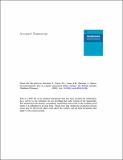Por favor, use este identificador para citar o enlazar a este item:
http://hdl.handle.net/10261/276908COMPARTIR / EXPORTAR:
 SHARE SHARE
 CORE
BASE CORE
BASE
|
|
| Visualizar otros formatos: MARC | Dublin Core | RDF | ORE | MODS | METS | DIDL | DATACITE | |

| Título: | Restoring paleomagnetic data in complex superposed folding settings: The Boltaña anticline (Southern Pyrenees) |
Autor: | Mochales López, Tania CSIC ORCID; Pueyo Morer, Emilio Luis CSIC ORCID; Casas-Sainz, Antonio M.; Barnolas Cortina, Antonio | Palabras clave: | Paleomagnetism vertical axis rotation restoration sequential Superimposed folding Pyrenees |
Fecha de publicación: | 28-ene-2016 | Editor: | Elsevier | Citación: | Tectonophysics 671: 281-298 (2016) | Resumen: | [EN] Complex kinematic scenarios in fold-and-thrust belts often produce superposed and non-coaxial folding. Interpretation of primary linear indicators must be based on a careful restoration to the undeformed stage following the reverse order of the deformation events. Therefore, sequential restoration to the ancient coordinate system is of key importance to obtain reliable kinematic interpretations using paleomagnetic data. In this paper, a new paleomagnetic study in the western flank of the Boltaña anticline (Southern Pyrenees) illustrates a case study of a complex tectonic setting having superposed, non-coaxial folds. The first stage of NW–SE folding linked to the oblique Boltaña anticline took place during Lutetian times. The second stage was linked to the vertical axis rotation and placed the Boltaña anticline in its present-day N–S configuration. Our data support a long-lasting Lutetian to Priabonian period with main rotational activity during the Bartonian–Priabonian; other authors support a VAR coeval with anticlinal growth. The third stage resulted in southwards tilting related to the emplacement of the N120E striking Guarga basement thrust (Oligocene–Early Miocene). Based on this deformational history, a sequential restoration was applied and compared with the classic bedding correction. At the site scale, single bedding correction gives errors ranging between 31° and − 31° in the estimation of vertical axis rotations. At the locality scale, in sites grouped in three folds (from W to E Arbella, Planillo and San Felizes), the bedding corrected data display rotation values in accordance with those found in the Ainsa Basin by other authors. Sequential restoration (based on the afore-mentioned evolution in three-steps) improves both some locality-means and the internal consistency of the data. Therefore, reasonably-constrained sequential restoration becomes essential to reconstruct the actual history of superposed folding areas. | Versión del editor: | https://doi.org/10.1016/j.tecto.2016.01.008 | URI: | http://hdl.handle.net/10261/276908 | DOI: | 10.1016/j.tecto.2016.01.008 | ISSN: | 0040-1951 |
| Aparece en las colecciones: | (IGME) Artículos |
Ficheros en este ítem:
| Fichero | Descripción | Tamaño | Formato | |
|---|---|---|---|---|
| restoring_paleomagnetic_data_2016.pdf | Postprint | 982,77 kB | Adobe PDF |  Visualizar/Abrir |
CORE Recommender
SCOPUSTM
Citations
12
checked on 25-abr-2024
WEB OF SCIENCETM
Citations
9
checked on 25-feb-2024
Page view(s)
35
checked on 01-may-2024
Download(s)
8
checked on 01-may-2024
Google ScholarTM
Check
Altmetric
Altmetric
NOTA: Los ítems de Digital.CSIC están protegidos por copyright, con todos los derechos reservados, a menos que se indique lo contrario.
